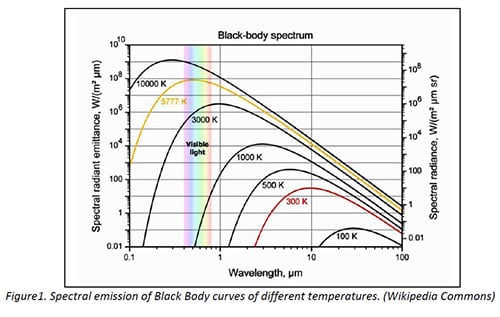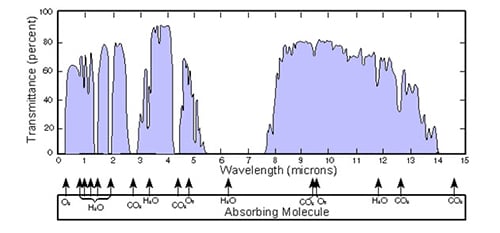The partial spectral overlapping applications of coating materials as the spectrum is traversed from visible (VIS) to infrared (IR) wavelengths was discussed. That overlap only pertained to wavelengths to ~5µm, and was satisfied by oxide and fluoride compounds. Longer wavelengths require different materials that exhibit low absorption. Additional properties are ease of deposition, available starting forms and conditioning, and the mechanical properties of the deposited film layers. First, we will review the IR spectrum.
Solar spectral emission conforms to ~6000 K black body radiation that peaks near 450 nm and supplies energy for human and animal vision as well as vegetation processes. Solar energy dwindles to smaller values as longer wavelengths are approached. The human eye has a spectral response between ~380 to 720 nm, with its photopic response peaking at 550 nm for bright light (daylight) and ~520 nm for scotopic response at low light level (moon light). CCD and CMOS camera sensors based on Silicon are filtered to mimic the RGB photopic response. Regions beyond the Near-Infrared are called Short Wavelength Infrared (SWIR) in wavelengths 1 to 3 µm (1000 to 3000 nm) and Mid-Wavelength Infrared (MWIR) for 3000 to 5500 nm. Long-Wavelength Infrared (LWIR), the “thermal band,” is between ~7 and ~11 µm. A set of black body curves is shown in Figure 1.

To be able to “visualize”, i.e., detect, monitor and image IR wavelengths, requires sensors with spectral responses at wavelengths longer than ~700 nm. Near-IR wavelengths can be sensed with silicon, VOx, GaAs and similar composition detectors. Objects can be viewed by reflected solar energy to wavelengths ~3 µm using sensors made of different semi-conductor materials.
At wavelengths longer than ~4 µm, solar reflected energy is very slight. Objects can be detected and imaged by their IR thermal emission which follows a black body curve that is determined by temperature as shown in Figure 1. Reflected solar energy is many orders of magnitude lower than emission at SWIR, MWIR and LWIR wavelengths. Radiation from sources near room temperature or 290 K (~20⁰ C) peak near 10 µm. The human body is a thermal emitter at 310 K or 37⁰ C, whose emission curve peaks at 9.6 µm. Water vapor in the atmosphere has spectral absorption bands between transparent windows (see Figure 2) which may pose significant design limitations. The MWIR window between ~3 and ~5 µm includes the CO2 band at 4.2 µm which is important to environmental studies. The LWIR window between ~8 and 14 µm – the “thermal band”- is open to the radiation of BB temperature near 9 µm. Therefore, it is ideal for sensing living bodies and other objects, whether natural or man-made.
